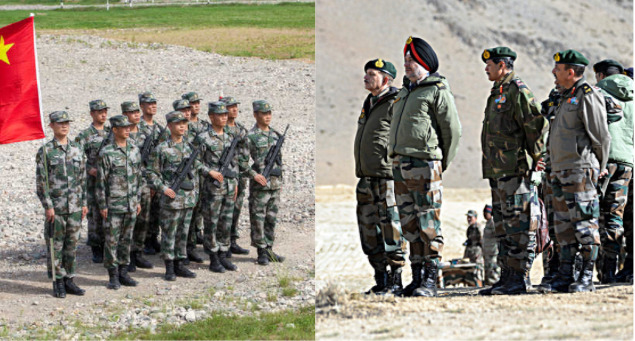China and its CCP-owned militia, the People’s Liberation Army, are indulging in rather hilarious psyops against the Indian Army, by no less than blazing Punjabi songs in certain friction areas between the two countries which are engaged in a tense and escalatory military standoff at Eastern Ladakh since May. Indian military commanders on the ground, along with their troops naturally couldn’t help but laugh at such desperate Chinese tactics to somehow catch their Indian counterparts off-guard, to mount an offensive against them, perhaps. On the southern bank of Pangong Tso, meanwhile, China has been deploying its worthless soldiers and PLA officials to blurt out in broken Hindi instigative talks against the Indian government in Delhi, with Beijing, hoping to brew rebellion among the Indian Army ranks.
For the uninitiated, China blasting Punjabi music to dissuade the Indian forces might be a classic psyops tactic, and nothing more. For those who are substantially better read when it comes to China, it would be known that such moves of the PLA stem from their inherent mix of the inferiority-superiority complex. Since almost all Chinese citizens in the mainland consider themselves of ‘Han’ descent, the PLA, too, mirrors similar demography. Now while the Chinese think of themselves as the most superior race sitting right in the middle of the world, subsequent defeats at the hands of foreign powers, including at the hands of Indian Sikhs has led to the breeding of a toxic inferiority complex as well.
Compounded with xenophobic racism, the Chinese hatred for Sikhs and bearded Indian with turbans on their heads knows no bounds. What also contributes to the desperate measures being employed by the PLA in Eastern Ladakh is a fear of the same Sikh soldiers which they hate. China, essentially, being the defeatist middle kingdom that it is, has not been able to overcome the fear of Punjabi-speaking Sikhs even a century later.
Over a hundred years ago, soldiers from the Sikh and Punjab regiments were brought into the Chinese mainland, including Beijing, to neutralise China’s Boxer Rebellion at the time. The said rebellion of China’s youthful farmers and workers was aimed at driving all foreign influence and individuals out of the mainland. As a trigger to an alliance offensive against them, the Boxer fighters threatened foreigners and kept 400 foreigners holed up in Beijing’s Foreign Legation Quarter. This led to a 55-day siege of the Legation Quarter by 20,000 alliance forces before they finally moved in and taught the Han supremacists a lesson which they haven’t forgotten to this very day.
Out of the 20,000 forces which defeated the Chinese, 8,000 soldiers were Indians, a majority of who belonged to the Sikh and Punjab regiments. The British had deployed Sikh soldiers as law enforcement officers in ports like Shanghai, where their trading companies had set up a large presence by the early twentieth century. The Sikh soldiers were feared by the Chinese for their imposing figures, so much so that the British deemed that they did not even need guns when on duty, Colonel G. Jaishankar, who has served as the Defence Attaché in the Indian Embassy in Beijing was quoted by the Hindu as saying.
This fear and hatred for Sikhs are what is dictating the PLA’s laughable moves in friction points along with Eastern Ladakh. What also contributes to the Chinese playing Punjabi music along the LAC is the sole identification of Indians as Sikhs, or as turban-wearing bearded men. Whenever the Chinese want to portray an Indian, the image of a Sikh is used as an easy indicator of the individual is from the south of the Himalayas, who has on more occasions than one, by the way, given the Chinese a beating which they cannot seem to forget.
Starting in 2019, there have been steps systematically taken by China to humiliate Sikhs and their religious symbols in terms of both their turban and beard being subjected to racist and xenophobic targeting by the Chinese. They are being forced to take off their turbans for official photographs and not being issued permits without it despite their passports having their pictures with turbans and the Chinese being informed of the religious significance of the same. Police stop Sikhs and tell them that if they wanted to live in China, they must remove their turbans and shave their beards.
Dr Isabella Jackson, who is an assistant professor in Chinese history in Trinity College, Dublin, talks about Indian depiction in popular Chinese history as following; “Such publications usually include a reference to the slang term by which the Sikhs were known by the Chinese, hongtauasan, which has been translated variously as the ‘red-headed monkeys’, ‘red-headed rascals’ or ‘turbaned number threes’. All reflect their status in Chinese eyes as the vicious lackeys of their British masters.” Whenever the Chinese take to mocking Indians, they unconsciously end up portraying a bearded Sikh for the role of an Indian.
#TheSpark: 7 Sins of India. It’s time for India to confess its SEVEN SINS. pic.twitter.com/vb9lQ40VPH
— China Xinhua News (@XHNews) August 16, 2017
China, under the regime of Chinese Communist Party for decades now, has idolised racism of all those who do not share a Han descent, thereby qualifying them as subjects of mockery and ones who deserve to be treated as sub-humans by the Chinese. Ironically, while the Chinese PLA look down upon Indians, particularly Sikhs and Punjabis, there is a visibly palpable fear in their minds for what the turbaned and bearded soldiers of the Indian Army can do to their ‘little emperors’.
